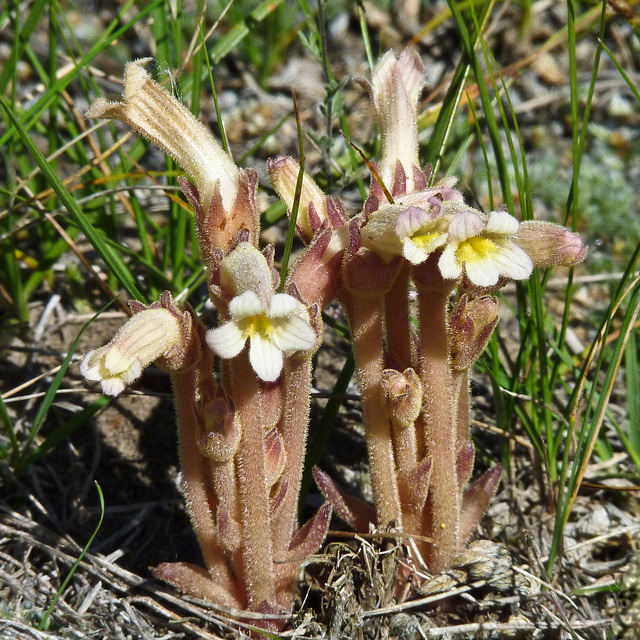Tiny Spotted Coralroot flower
Parasitic One-flowered Broomrape / Orobanche unifl…
Orobanche / Orobanche fasciculata
Pinedrops / Pterospora
The beauty of Pinedrops
Clustered Broomrape / Orobanche fasciculata
Clustered Broomrape / Orobanche fasciculata
Delicate Pinedrops / Pterospora andromedea
Pinedrops / Pterospora - rare, Listed S2
Pinedrops / Pterospora - rare
Pinedrops
Pinedrops
One-flowered Broomrape
Keywords
Authorizations, license
-
Visible by: Everyone -
All rights reserved
-
101 visits
Clustered Broomrape, Orobanche fasciculata


I very rarely see this unusual wildflower, so it's always a treat when we do come across it. This macro photo was taken on 27th June, when a few of us went down to south eastern Alberta for the day to botanize the Purple Spring Sand Dunes area, near Taber. This native plant grows on prairie grasslands and is in bloom June-August. It is parasitic on the roots of other plants, primarily those of Artemisia frigida (Pasture Sagewort).
"The stems are 2-10 cm tall, pinkish or brownish ... the leaves are alternate, scale-like and less than 1 cm long. Flower clusters are solitary or in 3-10-flowered racemes. Flowers are purplish, tube-shaped, irregula, 2-lipped, 2-3 cm long. Sepals 4-5, petals 5, stamens 4, pistils 1." From "Plants of Alberta" by Royer and Dickinson.
"As they have no chlorophyll, they are totally dependent on other plants for nutrients. Broomrape seeds remain dormant in the soil, often for many years, until stimulated to germinate by certain compounds produced by living plant roots. Broomrape seedlings put out a root-like growth, which attaches to the roots of nearby hosts. Once attached to a host, the broomrape robs its host of water and nutrients." From Wikipedia.
"The stems are 2-10 cm tall, pinkish or brownish ... the leaves are alternate, scale-like and less than 1 cm long. Flower clusters are solitary or in 3-10-flowered racemes. Flowers are purplish, tube-shaped, irregula, 2-lipped, 2-3 cm long. Sepals 4-5, petals 5, stamens 4, pistils 1." From "Plants of Alberta" by Royer and Dickinson.
"As they have no chlorophyll, they are totally dependent on other plants for nutrients. Broomrape seeds remain dormant in the soil, often for many years, until stimulated to germinate by certain compounds produced by living plant roots. Broomrape seedlings put out a root-like growth, which attaches to the roots of nearby hosts. Once attached to a host, the broomrape robs its host of water and nutrients." From Wikipedia.
- Keyboard shortcuts:
Jump to top
RSS feed- Latest comments - Subscribe to the comment feeds of this photo
- ipernity © 2007-2024
- Help & Contact
|
Club news
|
About ipernity
|
History |
ipernity Club & Prices |
Guide of good conduct
Donate | Group guidelines | Privacy policy | Terms of use | Statutes | In memoria -
Facebook
Twitter

Sign-in to write a comment.